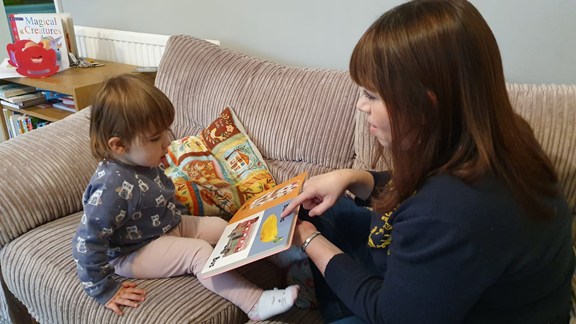My top tips for reading with my deaf daughter
Published Date: 24 Sep 2019
From a young age I have always had my head stuck in a book, my own mum recalls briefly believing I was a child genius at the age of two when I recited a book word for word. It was only when the pages stuck together they realised I had in fact memorised the whole thing!
When my daughter was born I was desperate to pass on my love of reading. We knew Isabelle was deaf very early on but needed to jump through the usual hoops before she was aided at eight weeks (and later implanted at 11 months). In the meantime, I didn’t want to wait to introduce her to the magic of the written word.
The typical image of a parent and child sharing a book tends to show the child sitting on their parent’s lap, both facing the book. This was never going to be practical in our case as we needed Isabelle to be able to see our faces to lip-read and gauge all of the non-verbal communication involved when reading. The dramatic “uh oh!” in We’re Going on a Bear Hunt or the sadness conveyed at the start of Monkey Puzzle when the main character can't find their mum. We read facing each other so we can draw Isabelle’s attention upwards, my husband and I are becoming experts at reading upside down!
Another great alternative is sitting with her on our lap facing a large mirror, this is lovely as we can still cuddle up but she is able to see our expression. We always make sure there's no background noise when we read to give her the best environment for hearing us.
It was a personal choice to sign with Isabelle as well as speak from the beginning, so we sign key words in the books too. This was especially useful in the month Isabelle was recovering from her implant operation when she had no hearing technology. It actually improved her eye contact and focus. Now she's a proficient signer and starting to speak, we choose books we know she can tell us about, particularly animal books. We'll say, “can you find the elephant Isabelle?” or point to the illustrations and ask “what's this?” This allows her to convey her knowledge and the active involvement holds her attention.
We're big fans of Julia Donaldson books such as The Snail and the Whale and The Smartest Giant in Town. They have fantastic illustrations with lots to talk about and help expand her vocabulary. They also have just the right amount of text to interest Isabelle. As an adult member of the deaf community, I know how hard it can sometimes be to concentrate on listening. As a young deaf child, it can take a lot of focus to hear the story so too much text on the page can sometimes be off-putting.
Books with repeated phrases are great to encourage joining in. We have some sound books such as Dear Zoo which we're using to help Isabelle match sounds to the source. One of the best parts of our day as a family is sharing Brown Bear, Brown Bear – What Do You See?, her current bedtime story. I look at her snuggled up, still captivated by the book we’ve read a hundred times and I know every step we've taken to meet her needs is worth it. We have another bookworm in the family!
